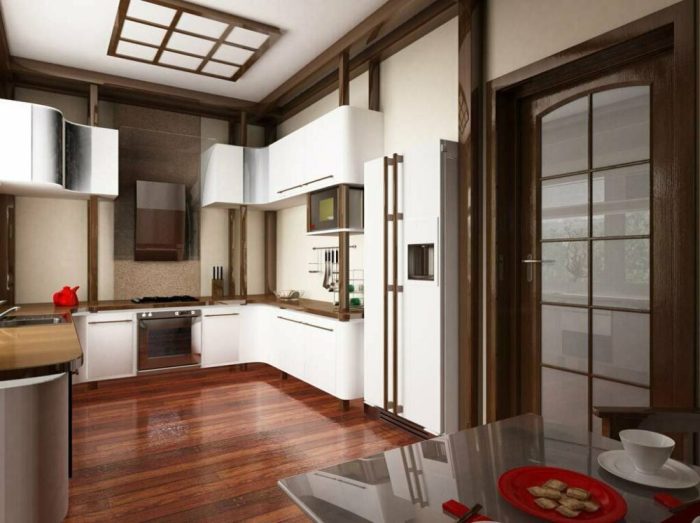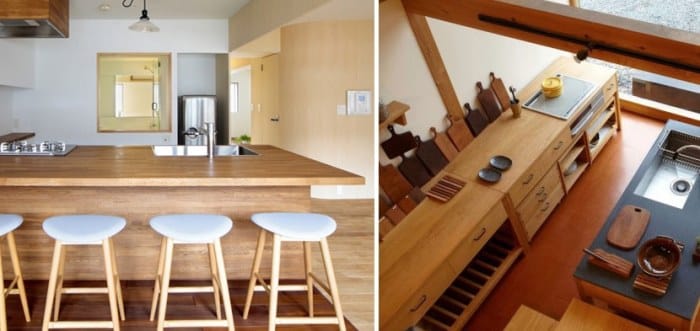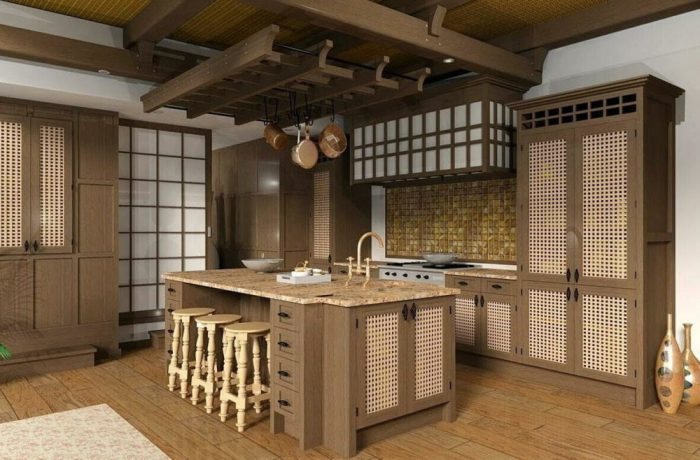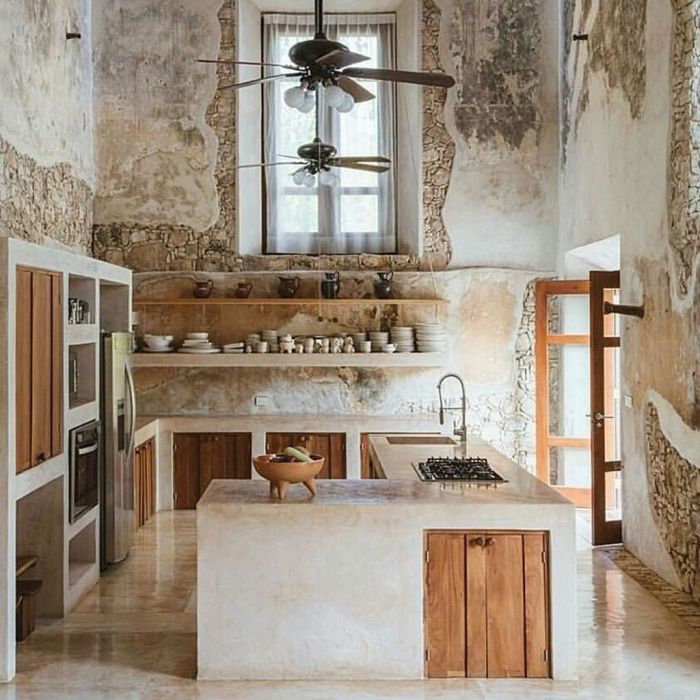The Japanese kitchen, a microcosm of efficiency and aesthetic harmony, offers a compelling study in design. Rooted in centuries-old traditions of minimalism and functionality, it prioritizes space optimization and the seamless integration of technology. Unlike Western kitchens often characterized by expansive countertops and abundant storage, the Japanese approach favors streamlined layouts, emphasizing the flow of movement and the careful selection of materials.
This exploration delves into the core principles, layout strategies, material choices, and technological advancements that define the unique allure of Japanese kitchen design, providing inspiration for modern kitchens worldwide. We will examine the interplay between traditional techniques and contemporary innovations, revealing how these kitchens achieve both practicality and a sense of serene tranquility.
From the meticulous arrangement of appliances to the careful selection of natural materials like wood and stone, every element contributes to a holistic design philosophy. This approach prioritizes not just visual appeal, but also the ergonomic aspects of cooking and food preparation. The exploration of different kitchen styles—modern, traditional, and farmhouse—reveals the versatility of this design approach, adaptable to various space constraints and personal preferences.
The study will cover space-saving techniques, innovative storage solutions, and the integration of smart technology, demonstrating how a Japanese kitchen can be both beautiful and highly functional, regardless of size.
Understanding Japanese Kitchen Design Principles

Japanese kitchen design prioritizes functionality and minimalism, reflecting a deep-seated cultural emphasis on efficiency, order, and harmony. These principles are not merely aesthetic choices but stem from practical considerations of space optimization in often smaller living spaces, coupled with a reverence for natural materials and a focus on reducing clutter. The result is a kitchen environment that is both aesthetically pleasing and highly effective.
Core Philosophies of Japanese Kitchen Design
The core philosophy underpinning Japanese kitchen design is
- shibui*, a concept encompassing understated elegance, simplicity, and natural beauty. This manifests in the selection of materials, the layout of the space, and the overall aesthetic. Functionality is paramount; every element serves a purpose, eliminating unnecessary ornamentation or features. The concept of
- ma*, or negative space, is also crucial. Strategic use of empty space enhances the overall design, creating a sense of calm and spaciousness, even in compact kitchens. This is achieved through careful consideration of the placement of appliances and cabinetry, ensuring smooth workflow and easy access to essential items. This approach directly contrasts with Western designs that often prioritize visual impact over practical functionality.
Typical Features of Traditional Japanese Kitchens
Traditional Japanese kitchens often feature low-slung counters and tatami mats, reflecting the traditional style of Japanese homes. Built-in cabinetry is common, maximizing storage space while maintaining a clean, uncluttered appearance. Natural materials like wood and bamboo are favored, contributing to the overall warmth and serenity of the space. The use of sliding doors (shoji) and screens allows for flexible partitioning and efficient use of space.
Furthermore, the integration of a small alcove (tokonoma), traditionally used for displaying flowers or artwork, can add a touch of elegance and tranquility. The incorporation of a low-to-the-ground cooking area, often featuring a gas stove and integrated sink, is typical, promoting ease of movement and reducing strain.
Comparison of Japanese and Western Kitchen Layouts
Japanese kitchen layouts emphasize efficiency and a linear workflow, often adopting a galley or L-shaped configuration to minimize unnecessary movement. Western kitchens, in contrast, often prioritize larger, more open layouts with an island as a central feature. This difference reflects cultural preferences for social interaction during food preparation in Western cultures, whereas Japanese design prioritizes streamlined functionality and quiet efficiency.
The use of built-in appliances and storage is far more common in Japanese kitchens, maximizing limited space. Western kitchens tend to incorporate more freestanding appliances, often leading to more visual clutter. Finally, the emphasis on natural materials in Japanese kitchens contrasts with the more diverse material palette often seen in Western designs.
Comparison of Three Japanese Kitchen Styles
| Style | Key Features | Space Utilization | Material Choices |
|---|---|---|---|
| Modern | Sleek, minimalist design; built-in appliances; efficient storage; often incorporates stainless steel and glass. | Highly efficient; maximizes space with clever storage solutions; often features a galley or L-shaped layout. | Stainless steel, glass, lacquered wood, high-tech composite materials. |
| Traditional | Low counters; tatami mats; natural wood cabinetry; sliding doors; often includes a small alcove (tokonoma). | Space-saving design through built-in features and sliding doors; emphasis on maximizing vertical space. | Natural wood (e.g., cedar, cypress); bamboo; paper screens (shoji); clay tiles. |
| Farmhouse | Blends traditional Japanese elements with rustic charm; incorporates natural wood and exposed beams; may feature open shelving. | Utilizes a blend of built-in and freestanding storage; often incorporates a more open layout than traditional styles. | Reclaimed wood; exposed beams; natural stone; simple, unvarnished finishes. |
Space Optimization and Layout Strategies

Japanese kitchen design prioritizes efficiency and functionality, especially crucial given the often-limited living spaces in many Japanese homes. The principles of minimalism and maximizing vertical space are paramount, resulting in kitchens that are both aesthetically pleasing and highly practical. This focus on space optimization stems from a cultural appreciation for tidiness and a pragmatic approach to resource management.
Efficient Space Utilization in Small Japanese Kitchens
The limited square footage common in Japanese homes necessitates a meticulous approach to kitchen design. Every inch must be carefully considered and utilized to its fullest potential. This translates to a deep understanding of ergonomics, ensuring that frequently used items are easily accessible, minimizing wasted movement and maximizing workflow efficiency. Research by the Japan Housing Finance Agency consistently shows that smaller kitchen spaces are prevalent, driving innovation in compact kitchen designs.
This compact design is not merely a constraint; it fosters creativity in storage solutions and workflow optimization.
Materials and Aesthetics
The aesthetic of a Japanese kitchen is deeply intertwined with the materials used in its construction. The philosophy emphasizes natural beauty, functionality, and a sense of calm, achieved through a careful selection of materials and their integration into the overall design. These choices reflect centuries of tradition and a deep appreciation for the inherent qualities of natural elements.
The careful selection of materials is not merely aesthetic; it also impacts the kitchen’s durability, practicality, and overall atmosphere. The interplay between texture, color, and the inherent properties of each material contributes to a holistic design that transcends mere visual appeal.
Common Materials in Japanese Kitchen Design
Japanese kitchens often feature a harmonious blend of natural materials, each contributing unique visual and functional properties. Wood, for instance, is a cornerstone, often appearing in cabinetry, countertops, and flooring. Its warmth and inherent beauty bring a sense of serenity and connection to nature. Natural stone, such as granite or slate, adds a touch of sophistication and durability, particularly for countertops.
Its cool texture provides a pleasing contrast to the warmth of the wood. Lacquer, a traditional Japanese finish, adds a layer of elegance and protection, often seen on cabinetry or decorative elements. Its glossy sheen reflects light, enhancing the feeling of spaciousness. Finally, paper, surprisingly, plays a role, used in shoji screens or as a subtle accent, bringing a sense of lightness and traditional Japanese aesthetics.
Aesthetic Contributions of Materials
The use of wood in Japanese kitchen design contributes significantly to its overall aesthetic. The natural grain and color variations of wood, particularly cherry or cedar, create a visually appealing and warm environment. The subtle variations in color and texture introduce a sense of depth and visual interest. The tactile quality of wood adds to the sensory experience of the kitchen, creating a comforting and welcoming space.
Natural stone, on the other hand, introduces a sense of solidity and permanence, complementing the warmth of the wood. Its smooth, cool surface provides a pleasing contrast, both visually and texturally. The use of lacquer, with its glossy finish, adds a touch of sophistication and modernity, while still retaining a connection to traditional Japanese craftsmanship. The reflective qualities of lacquer also contribute to the perception of a more spacious and airy kitchen.
Color Palettes for a Serene Atmosphere
Color plays a crucial role in shaping the mood and atmosphere of a Japanese kitchen. The emphasis is on creating a calming and serene environment that promotes relaxation and well-being. This is often achieved through a restrained use of color, favoring muted tones and natural hues. The careful selection of color palettes reinforces the overall design aesthetic, enhancing the feeling of harmony and balance.
Five Popular Color Palettes for Japanese Kitchen Design
The following palettes illustrate the typical approach to color selection in Japanese kitchen design, emphasizing natural hues and a sense of tranquility.
- Earthy Neutrals: This palette centers around beige, taupe, and warm grays, complemented by accents of natural wood tones. It evokes a sense of calm and understated elegance. Imagine a kitchen with light beige walls, dark wood cabinetry, and taupe countertops.
- Cool Greens and Blues: Inspired by nature, this palette incorporates muted greens and blues, reminiscent of forests and serene waters. These colors are often combined with white or light gray for a refreshing and calming effect. Picture soft sage green cabinets paired with light blue accents and white walls.
- Monochromatic Serenity: This approach utilizes variations of a single color, such as different shades of gray or beige. The subtle shifts in tone create visual interest without overwhelming the space. Consider a kitchen with various shades of gray, from light gray walls to charcoal gray cabinetry.
- Natural Wood and White: This classic combination highlights the beauty of natural wood, balanced by the crispness of white. White walls and ceilings create a sense of spaciousness, while wood cabinetry and flooring provide warmth and texture. This palette is simple yet elegant.
- Black and Natural Wood: A more dramatic approach, this palette utilizes black as an accent color against a backdrop of natural wood. Black accents, such as hardware or lighting fixtures, add a touch of sophistication and contrast. Imagine dark wood cabinets paired with black countertops and sleek black hardware.
Appliances and Technology

The Japanese kitchen, renowned for its efficiency and aesthetic minimalism, seamlessly integrates modern appliances without compromising its characteristic understated elegance. This integration is achieved through careful consideration of both functionality and form, prioritizing space-saving designs and technologically advanced features that enhance the cooking experience. The selection and placement of appliances reflect a deep understanding of ergonomics and workflow, resulting in a kitchen that is both beautiful and highly practical.
Space optimization is paramount in Japanese kitchen design, and this principle extends to the choice of appliances. Manufacturers have responded to this demand by creating a range of compact and multi-functional appliances specifically tailored for smaller spaces. The integration of technology further enhances this efficiency, with smart appliances offering features that streamline cooking processes and minimize energy consumption.
Space-Saving Appliances in Japanese Kitchens
Japanese kitchens often utilize appliances designed to maximize space efficiency. This includes compact refrigerators with clever internal organization, slim-line dishwashers that fit seamlessly under counters, and multi-functional ovens that combine microwave, convection, and grilling capabilities in a single unit. Induction cooktops, requiring less counter space than traditional gas or electric ranges, are also popular. These appliances demonstrate a commitment to functionality without sacrificing valuable counter or storage space.
The integration of these space-saving designs exemplifies the Japanese philosophy of “mottainai,” minimizing waste and maximizing resource utilization.
Smart Technology in Contemporary Japanese Kitchens
Smart technology is increasingly prevalent in contemporary Japanese kitchen designs, offering convenience and efficiency. Smart refrigerators with inventory management systems help minimize food waste, while smart ovens allow for remote preheating and precise temperature control. Integrated scales and recipe management software can streamline the cooking process, while smart ventilation systems automatically adjust based on cooking needs. This sophisticated integration of technology enhances the user experience, making cooking more efficient and enjoyable, all while aligning with the minimalist aesthetic of the kitchen design.
Range Hood Comparison
The range hood is a crucial element in maintaining a clean and pleasant cooking environment. Japanese kitchens often feature sleek, integrated designs that blend seamlessly with the overall aesthetic. The following table compares three common types of range hoods found in Japanese kitchens:
| Model Type | Features | Dimensions (approx.) | Energy Efficiency |
|---|---|---|---|
| Under-Cabinet Downdraft | Concealed within cabinetry, powerful suction, easy cleaning, touch controls | Width: 24-30 inches, Depth: Varies based on model | Generally high, often with energy-saving modes |
| Island Range Hood | Stylish, often with LED lighting, multiple fan speeds, adjustable height | Width: 24-48 inches, Height: 12-24 inches, Depth: Varies based on model | Moderate to high, depending on the model and features |
| Wall-Mounted Canopy | Classic design, effective ventilation, easy access to filters | Width: 24-36 inches, Height: 12-18 inches, Depth: Varies based on model | Moderate to high, depending on the motor and fan technology |
Illustrative Examples of Japanese Kitchen Layouts

Japanese kitchen design, deeply rooted in cultural values and practical considerations, showcases a fascinating interplay of aesthetics, functionality, and space optimization. This section explores four distinct examples, each highlighting a different approach to achieving a harmonious and efficient culinary space. The examples range from traditional designs emphasizing natural materials to contemporary layouts incorporating cutting-edge technology, demonstrating the versatility and adaptability of Japanese kitchen principles.
Modern Japanese Kitchen with an Island
This design features a spacious L-shaped kitchen with a central island, a common layout in contemporary Japanese homes. The island, approximately 2.4 meters long by 1.2 meters wide, serves as a multi-functional hub. One side incorporates a built-in gas cooktop and range hood, seamlessly integrated into the countertop made of durable, heat-resistant granite. The other side provides ample seating for casual dining or meal preparation.
The cabinetry is minimalist, crafted from light-colored oak, reflecting the natural light that floods the space through large windows. High-end stainless steel appliances, including a built-in refrigerator and dishwasher, are discreetly integrated, maintaining a clean and uncluttered aesthetic. The backsplash is a simple, yet elegant, mosaic tile in muted earth tones. The overall color palette is calm and neutral, fostering a sense of tranquility.
Traditional Japanese Kitchen
In contrast to the modern example, this traditional kitchen embraces natural materials and emphasizes functionality. The layout is typically linear, often positioned along a wall. The primary material is wood, often hinoki cypress, known for its durability and pleasant aroma. Storage is maximized through the use of deep, built-in cabinets and drawers, often extending from floor to ceiling.
A low, wooden countertop, approximately 80 centimeters high, facilitates comfortable use while seated on tatami mats, a traditional floor covering. Appliances are minimal, often consisting of a gas cooktop and a rice cooker. The aesthetic is understated and warm, reflecting a connection to nature and traditional Japanese craftsmanship. The overall space is compact, approximately 3 square meters, demonstrating efficient use of limited space.
Contemporary Japanese Kitchen with Minimalist Design and Smart Technology
This kitchen epitomizes minimalist design principles. Clean lines, a neutral color palette (primarily white and gray), and a lack of ornamentation characterize the space. The layout is typically a galley kitchen, maximizing space efficiency. The countertops are made of sleek, white quartz, and the cabinetry is handleless, contributing to the minimalist aesthetic. Smart technology is integrated seamlessly.
This might include a touch-screen control panel for lighting and appliances, automated storage solutions, and a built-in smart refrigerator with inventory management. Appliances are high-end and energy-efficient. The overall feel is modern, clean, and technologically advanced. The space, approximately 4 square meters, demonstrates how minimalism can enhance functionality.
Japanese Kitchen Incorporating a Tatami Mat Area
This design integrates a small tatami mat area (approximately 1.8 meters by 1.2 meters) adjacent to the kitchen, creating a distinct transition zone between the kitchen and the rest of the house. The tatami mats, made of woven rush grass, provide a comfortable seating area for informal meals or tea ceremonies. The kitchen itself is a simple galley style, with a wooden countertop and traditional cabinetry.
The flooring transitions seamlessly from the tatami mats to the kitchen’s tiled floor, using a low threshold to maintain a sense of flow. The overall aesthetic is one of calm, natural beauty, showcasing the integration of traditional Japanese elements into a modern kitchen design. The materials are primarily natural—wood, tatami mats, and ceramic tiles—creating a serene and welcoming atmosphere.
Closure
In conclusion, the allure of Japanese kitchen design lies in its ability to seamlessly blend functionality with aesthetic beauty. By prioritizing space optimization, minimalist aesthetics, and the integration of technology, Japanese kitchens offer a compelling model for modern living. Whether it’s the incorporation of traditional elements like tatami mats or the embrace of contemporary smart appliances, the underlying principle remains consistent: to create a space that is both efficient and calming, reflecting a deep respect for both the craft of cooking and the art of living well.
The versatility of Japanese kitchen design allows for adaptation to various spaces and personal styles, proving that a harmonious and highly functional kitchen is achievable, regardless of size or aesthetic preference.
Questions and Answers
What are some common challenges in designing a Japanese-inspired kitchen in a Western home?
Adapting Japanese design principles to Western homes often involves overcoming differences in space, plumbing, and electrical systems. Finding appliances with the appropriate dimensions and aesthetic can also be challenging. Cultural differences in cooking practices might also require adjustments to the layout and equipment.
How can I incorporate Japanese design elements without a complete kitchen renovation?
Simple changes like introducing natural materials (wood, bamboo), minimalist storage solutions, and a calming color palette can subtly evoke a Japanese aesthetic. Decluttering and reorganizing existing cabinetry can also enhance the sense of order and efficiency.
Are Japanese kitchens suitable for large families?
While known for their efficiency in smaller spaces, Japanese design principles can be adapted to larger kitchens. The focus remains on optimizing workflow and creating a functional, clutter-free environment, even with more space and appliances.
What are the typical costs associated with building a Japanese-style kitchen?
Costs vary significantly based on size, materials, appliances, and the extent of renovation. High-end materials like natural stone and custom cabinetry can increase expenses. However, a focus on efficiency can sometimes offset costs by reducing the need for extensive storage.
Where can I find reliable resources for Japanese kitchen design inspiration?
Architectural and design magazines, online platforms like Pinterest and Houzz, and books on Japanese interior design offer a wealth of inspiration. Visiting showrooms specializing in Japanese-inspired kitchen design can also be beneficial.